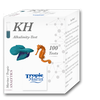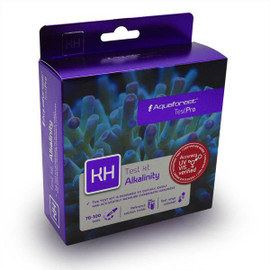Measuring range & accuracy
Measurement range: 1 - 20 dH
Accuracy: 0.5/1 dH
About alkalinity
The carbonate hardness (KH) or alkalinity of a water sample characterises the buffering capacity, i.e. the ability to maintain the pH value of the water.
There are many terms in water chemistry to describe the buffering capacity with varying definitions. The term “carbonate hardness” is customary in fishkeeping; however, it is the alkalinity which is measured. In this test, both terms are used synonymously. The reading for alkalinity is usually given in degrees of German hardness (dH). You can find a table for converting this unit into other common units in these instructions.
The alcalinity should be tested in all aquariums with great regularity. If the alkalinity in the aquarium is too low, the pH value can sink (sudden drop in acidity) to a level which is life-threatening for many fish and invertebrates. In reef aquariums, an adequate alkalinity level is essential for strong coral growth. On the other hand, an overly high alkalinity in saltwater tanks can lead to calcium carbonate precipitates and also have a negative impact on coral growth.
The alkalinity in saltwater aquariums should range from 6 to 9 dH. The alkalinity in freshwater aquariums should not fall below 3 dH. The optimum alkalinity level in freshwater aquariums depends on the species of fish and plants you are looking after. Ask your specialist retailer for the correct alkalinity level for your aquarium.
Package contents
- 25 ml / 0.85 fl.oz. of reagent KH
- 1 glass cuvette 10 ml
- 1 dosing syringe 5 ml
- 1 instructions for use

Instructions for use
- Shake the dropper bottle before use!
- Rinse out the glass cuvette with tap water and then several times with aquarium water.
- Fill the glass cuvette with exactly 5 ml of aquarium water using the dosing syringe.
- Now add the KH test reagent drop by drop (shake the cuvette after each drop), until the colour of the solution changes from TURQUOISE to PINK.
- The number of drops indicates the alkalinity of the solution in dH, e.g. 8 drops = 8 dH. To increase the accuracy of the measurement, a 10 ml water sample (instead of 5 ml) can be used. In that case, 1 drop corresponds to 0.5 dH, i.e. 15 drops = 7.5 dH.
- Rinse out the glass cuvette and the syringe thoroughly with tap water after the measurement process.
Shelf life and storage:
6 months after opening. Store in a cool, dark place.
Schedule of water hardness:








